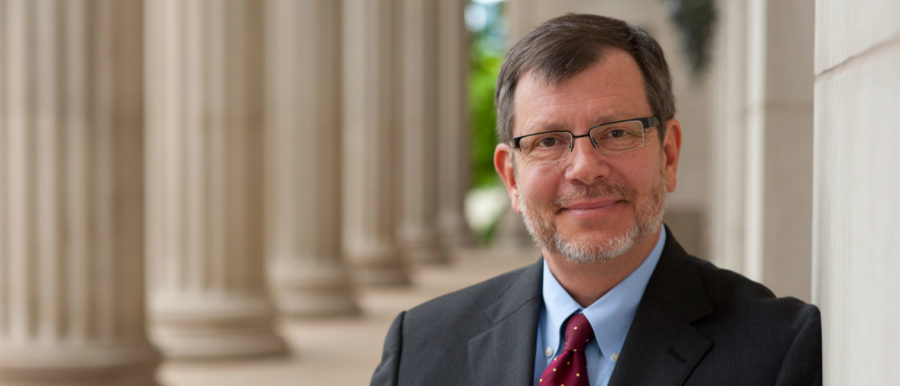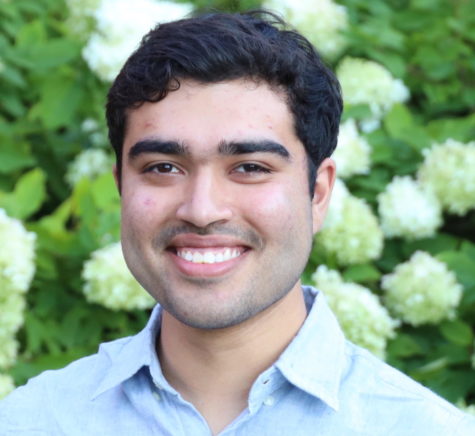President Eric Kaler shares plan for the years ahead at USG assembly
President Eric Kaler outlined his goals for the CWRU community in a speech at the USG General Assembly on Sept. 14.
September 17, 2021
Following President Barbara Snyder’s departure, Interim President Scott Cowen’s COVID-filled socially-distanced tenure and a year-long search for a replacement, Eric Kaler is now the president of Case Western Reserve University. Kaler’s former tenure as the president of the University of Minnesota was defined by a commitment to an increase in research expenditures and in fundraising in general. A chemical engineer by profession, Kaler stepped down in 2019 to join U of M’s Department of Chemical Engineering, saying that he had done “all that [he] set out to do” as president. However, this brief return to teaching and research at the U of M was short-lived. Kaler was selected as CWRU’s new president in October 2020 and was instated on July 1, 2021, facing various crises in addition to the prospect of reopening campus in the midst of a pandemic.
The Kaler era began with a bang, with an announcement on July 15 that all students, staff and faculty must receive a vaccination for COVID-19 if they wish to return to campus. Soon after, in early August, an indoor mask mandate was reinstated with the surge of the Delta variant of COVID-19, and surveillance testing was announced to return. Now four weeks into the semester, at least 98% of students are confirmed to be vaccinated, and the percentage of positive cases has remained consistently low—now on the decline—with a positivity rate of only 0.24% in the week of Sept. 7. As such, the return to campus seems to be an unmitigated success on the part of CWRU administration. Now comes the rest of the Kaler agenda.
On Tuesday, Sept. 14 at 7 p.m., President Kaler came to the Undergraduate Student Government (USG) General Assembly to lay out his motivations for joining CWRU, explain his plans as president and answer any questions that our student representatives had prepared for him. Taking place in the Toepfer room of Adelbert Hall, the speech marked the first occasion that President Kaler had spoken to CWRU’s student body representatives as well as his first time laying out his plans in a public setting, as any student is allowed to attend a USG General Assembly. This also was the first opportunity for students to directly ask questions to President Kaler, though most questions were pre-screened and pre-provided to the president’s office.
President Kaler started out his remarks speaking to the merit of being in student government, playing to the audience, then shifted his attention to the series of armed robberies that occurred on or near campus in the past week. A student was robbed at gunpoint and carjacked around the Village at 115th on Northside on Saturday, Sept. 11, and a community member unaffiliated with CWRU was held at gunpoint by three individuals whom he subsequently chased from Cedar Ave. all the way to Wade Lagoon while being shot at on Tuesday, Sept. 14. To this, Kaler impressed on all those present that chasing after robbers isn’t a good idea: “I really shouldn’t need to say this, but I’m going to. Nothing you own is worth dying for.” Beyond that, Kaler remarked that while there will be an additional police presence, “it is impossible to police our way out of the situation,” and that ultimately, it is up to CWRU students to take a proactive approach towards their own safety, whether by traveling in groups more often or by taking Safe Rides. He did, however, acknowledge that Safe Ride wait times are too long, with students often reporting waits stretching into the hours. “We are working on that,” was all Kaler had to say on that matter before proposing a door-knocking campaign that USG could implement to share information about how to stay safe on an urban campus—a strategy that he previously used at the U of M.
President Kaler then moved on to the main focus of that night’s speech—introducing himself to the student government. Starting with his general history and how he came to CWRU, Kaler remarked that when he stepped down as president of the U of M, he found himself missing the leadership opportunities that came with the position. However, for his new potential position, he wanted to be at a private university as opposed to a public university, one that was STEM-heavy while still being “broad and comprehensive” and one that was located in an urban area. Then, as his story goes, when the CWRU search committee came calling, he found our university to be a perfect fit, saying, “I am excited as can be to engage in the future of this institution. We are poised for really wonderful things, and it’s going to be exciting, interesting, challenging [and] fun to move those forward together.”
He then spoke about the COVID-19 case numbers on the CWRU campus, commending students for their strong vaccination numbers: “I think we’ve succeeded—knock on wood—in making a little bubble around us that will keep us safe and let us remain in person through the semester.” He was sure to note, however, that the bubble did not extend throughout Cuyahoga County. For this reason, the mask mandate would remain in place, and the university would continue to monitor for any new variants that might disrupt campus life. “We are, I think, going to have COVID with us for the foreseeable future in one way or another, so we are going to have to learn to live with it.”
Kaler then outlined his five-point agenda: community safety, increasing the size and diversity of the student population, community service, expanding research and driving dollars to our academics on the business end. The community safety aspect mostly entails the aforementioned COVID-19 protocols and crime reduction strategies. Kaler then spoke on CWRU’s seeming ability to “digest” our largest-ever first-year class without many hiccups, saying, “So that tells me that we have some additional capacity for undergraduate students, and we will be looking at moving the size of our entering classes up very modestly. That will allow us to offer additional spots to students that we think are qualified and also moves in line with our goals of increasing the diversity in every dimension of our entering class.”
Moving forward, Kaler arrived at the bulk of his speech, describing how CWRU should re-engage with the Cleveland community at large. He began by speaking on how he spent the majority of his career at public institutions and land-grant institutions, from which he learned that universities must go beyond simply teaching and research and rather take “responsibility to serve the communities in which [they] are located.” He then went on to describe a number of ways CWRU can help face problems in Cleveland communities.
“We have a huge set of resources that we can bring to a myriad of problems … and unfortunately some of our nearby neighborhoods have some problems that we can work on. Our dental students should be in the community, our medical students and pre-med students should be doing screenings. If you get an eviction or have other problems in the neighborhood, one of the clinics in our law school should be the first place that you start. We have a lot of opportunities in student engagement, whether it’s Engineers Without Borders or other social ways to engage and improve the lives of those that live near our campus.”
Kaler did not have much to say on his research and monetary priorities to USG, as he quickly moved on to a Q&A session. The first question asked if CWRU still planned on divesting from fossil fuel companies, to which he unequivocally answered yes, saying that it would happen within the next three years and that the university would be as transparent as possible in the process. “I think this is a great example of students and administration collaborating.” Kaler faced a number of other questions on transparency in the university, with many concerned that it would be back to the days of an administration not sharing crucial information about how decisions that affect the entire campus community were being made.
To this, Kaler said, “You know, I’m a huge fan of being as transparent as you can be, but sometimes there are confidential limits, personal law limits [or] donor limits. You can’t be, you know, completely transparent, even though sometimes people like to debate, but if I can’t be transparent, you’ll know why … We have nothing to hide. So why wouldn’t we be transparent?” On this note, The Observer has been requesting an interview with President Kaler since July and still has not received a reply from his administration.
President Kaler then fielded a number of other questions and detailed how CWRU continues in planning to build new dorms on Southside over existing parking lots, with the potential of cycling students through these new residence halls as others across Southside and Northside are renovated. Other topics covered in the session involved redeveloping parts of the Case Quad, changing CWRU’s hiring culture to include more faculty members of color, building a better apparatus to “extract money from the federal government” and comment on how the university budget isn’t necessarily nontransparent but rather a bit complicated—“But most of you, you got into Case Western Reserve, so you’re probably smart enough to figure out the budget … But there’s a difference between having something be complicated and not being transparent.”
A last point that President Kaler covered was in addressing any concerns those involved in the humanities might have, given Kaler’s STEM background and priorities around STEM research. “Whenever an engineer becomes president of the university, the humanists say, ‘Oh my god, we have an engineer as the president of the university.’ I get it. But the humanities are actually the reason for humans. Understanding of philosophy, of psychology, of who we are and why we are, the ability to communicate in writing or electronically, the ability to create art and music and theater. These are the things that make us human. So we’re not going to slack on that space at all.”
He then pointed to the number of cultural institutions around campus, such as the Cleveland Orchestra, the Cleveland Museum of Art as well as the newly-opened Maltz Performing Arts Center, adding, “So it would be almost as stupid to neglect the humanities and the creative arts here as it would be to neglect medicine. And there’s no reason we can’t [support] both.” He then went on to jokingly say that despite his being an engineer, his wife was an arts major, so to ensure domestic tranquility, he would be sure to continue to invest in the humanities.
“At the end of the day, we are here to educate you, and we’re here to create new ideas, new inventions and businesses, to create cures and treat patients. Those are the things we do. And we will do them through every aspect of the university.”



